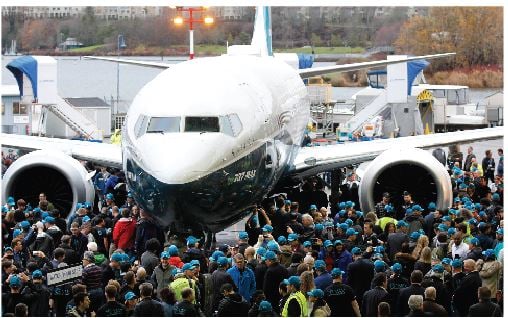Prime
REVIEW: Disturbing tale of how Boeing flew without wings

Boeing workers and VIPs surround the first 737 MAX jet to roll out in Renton, Wash., in 2015. PHOTO | Boeing
Be they a frequent flyer or someone clocking up their first air miles, it is normal to be sufficiently concerned whenever a plane accelerates down the runway for take-off. When Ethiopian Airlines Flight 302 set off on what was hoped to be a routine journey from Addis Ababa to Nairobi, the aircrew—that was meticulous in reviewing even the smallest details—didn’t expect to be thrown off its tail.
Yet, barely seconds into the flight, Yared Getachew and Ahmednur Mohammed knew that something had gone awry. The control column reverberated in Getachew’s hands. Soon the dashboard flashed altitude and airspeed warnings, showing the captain and first officer that something of the gravest nature had occurred.
“Getachew reported a ‘flight control problem’ to the tower. Then the nose pitched down,” Peter Robison describes in breathless detail events leading up to the March 10, 2019, crash in his powerful, if unsettling, book, Flying Blind: The 737 MAX tragedy and the fall of Boeing. “The angle-of-attack vane on the captain’s side was reporting to the flight control computer that the jet was ascending at an almost-vertical seventy-five degrees sixty degrees higher than the gentler, routine climb out that was actually taking place.”
In the suspenseful exposé, Robison reveals that the young aircrew (both were aged under 30) knew straightaway that the Manoeuvring Characteristics Augmentation System or MCAS malfunction was eerily similar to the Lion Air Flight 610 that plunged into the Java Sea on October 29, 2018. While the two aircrews differed in their knowledge of the upheavals at hand (the Flight 302 aircrew hollered “left alpha vane!” almost in unison), the outcomes were the same.
The steep nose-down angle plunge of the Lion Air Flight 610 claimed all 189 passengers and crew 13 minutes after takeoff. Flight 302 vanished off the radar six minutes after takeoff. Amongst the 157 fatalities was Christine Alalo, a commissioner with the Uganda Police Force, who was 11 days shy of turning 49.

Boeing workers and VIPs surround the first 737 MAX jet to roll out in Renton, Wash., in 2015. PHOTO | Boeing
Besides the ill-fated Lion Air and Ethiopian Airlines aircrafts being Boeing 737 MAX 8s, Robison—an investigative journalist with Bloomberg—clinches his argument about a century-old behemoth of the aviation industry flying blind by pointing out a profoundly broken corporate culture. Displaying a lawyerly command of facts, the evidence he adduces is oftentimes deeply disturbing.
Robison’s page-turner is terrifying in its controlled weighty study of Boeing’s propensity to choose profit over quality. His blow-by-blow account of how Boeing—in cahoots with regulators at the Federal Aviation Administration or FAA—came to the conclusion that its pilots could do without hours of flight simulator training for the MAX 8 is as cringeworthy as it is intriguing.
“Paying for pilots, maintenance, and cabin crews, plus all of the training needed to operate aircraft safely, comes to 20 percent of an airline’s operating budget—more than is spent on fuel,” he writes, adding, “ It was in the aircraft manufacturer’s and the airline’s short-term financial interests, then, to keep the burden of simulation training to a minimum.”
A simulator would have, Robison opines, conveyed the sense of helplessness that Captain Getachew and First Officer Mohammed were condemned to on Flight 302. Robison hypothesises that if their 4,327 flight hours logged on a 737 didn’t help them crack a puzzle so fiendishly complex, as indeed was the case on March 10, 2019, “the instructor would have calmly stopped the demonstration and explained the trim wheel, how they needed to make sure to slow down and neutralise the forces first.”
Shorn of the MAX simulator training, the pilots—for all intents and purposes—flew blind on March 10, 2019. Describing the opportunity cost Boeing fat cats entertained, one observer colourfully held that: “It’s like swapping fries for boiled potatoes.”
Robison also digs into the annals to show how “holding the purse strings as tightly as ever” produced costly errors intended “to save valuable interior cargo space” such as “a door [on the DC-10 plane] that opened outward.” In March of 1974, all 346 people aboard a DC-10 died when “an explosion blew out the cargo door …”
After a number of close shaves, the FAA had been convinced—rather remarkably—that adding a support plate to the door would suffice. It didn’t. Of course. This and other anecdotes about how authorities seemed tone-deaf to concerns around vulnerability of plane parts to fatigue can prove to be quite discomforting. Such is the penetrating insight of this page-turner that when a reader flips the last page, it dawns on them that getting a seat at the overwing exit is not the only troubling thing when you jump onto a plane. A Boeing 737 at that.




